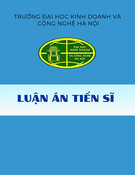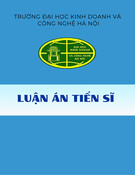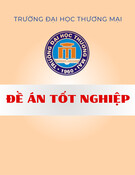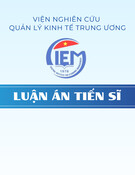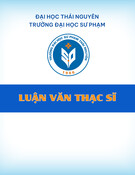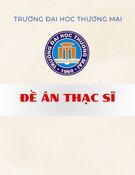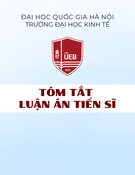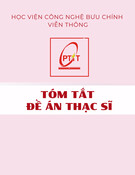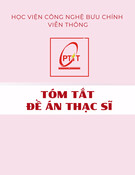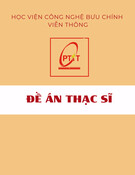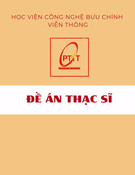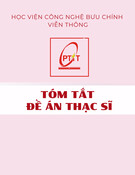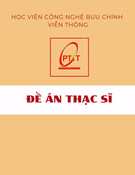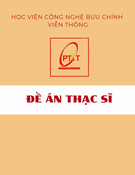
MINISTRY OF EDUCATION AND TRAINING
HANOI NATIONAL UNIVERSITY OF EDUCATION
PHAM THI MINH HIEN
MANAGING RISK - BASED EXTERNAL
QUALITY ASSURANCE OF COLLEGES
Major: Educational Management
Code: 9 140114
DOCTORAL THESIS IN EDUCATIONAL SCIENCE
HA NOI, 2025

The thesis is completed in Hanoi National University of Education
Supervisors:
1. Dr. Hoang Thi Kim Hue
2. Dr. Vu Xuan Hung
Reviewer 1: Assoc. Prof. Dr. Nguyen Vu Bich Hien
Party Committee of Hanoi Universities and Colleges
Reviewer 2: Assoc. Prof. Dr. Nguyen Van Tuan
Hanoi Metropolitan University
Reviewer 3: Assoc. Prof. Dr. Nguyen Nhu An
Hanoi National University of Education
The thesis will be defended at the Committee
of University-Level Thesis Defense of
Hanoi National University of Education at …..
The thesis can be found in: National Library of Hanoi or Library of Hanoi
National University of Education

LIST OF PUBLISHED ARTICLES AND WORKS
RELEVANT TO THE STUDY TOPIC
TT
Titles of Articles pubished from 2021 – 2025
During PhD study time
1
Pham Thi Minh Hien (2025). Sollutions for risk-based external QA
management for colleges. Vietnam Journal of Educational Sciences, Vol.
22, No. 04, 2025.
2
Phạm Thị Minh Hiền – Hoàng Thị Kim Huệ (2024). Risk-based external
QA in VET - International Experiences and Lessons learnt for Viet Nam.
Vietnam Journal of Educational Sciences, Volume 20, number 9, 2024.
3
Phạm Thị Minh Hiền – Hoàng Thị Kim Huệ (2024). Post Secondary
Accreditation in the United States and Lessons learnt for Viet Nam. Journal
of Education, Volume 24, Special Edition 11, 2024.
Before PhD study time
4
Pham Thi Minh Hien (2021). The Australian VET QA system and policy
recommendations for Vietnam. VET Journal, General Department of VET,
No. 88, January 2021
5
Do Nang Khanh, Pham Thi Minh Hien (2019). VET quality assessment -
Current situation and some policy recommendations.
Proceedings of the National Conference - Vietnam Education Science
Conference 2019 (VEC2019). VET development in the context of growth
transformation and international integration (International Standard Book
Number – ISBN 978-604-65-5370-2)

1
INTRODUCTION
1. Rationale for the study
1.1. High-quality human resources will contribute to enhancing national
competitive productivity and are the foundation of sustainable development. In
Vietnam's Socio - Economic Development Strategy for the period 2021-2030, the Party
continues to identify human resource development, especially high-quality human
resources, as one of the three strategic breakthroughs.
Vocational Education and Training (VET), with the mission of training, fostering,
and providing skilled labor for the Vietnamese workforce, plays a crucial role in
improving the quality of human resources, making a significant contribution to
achieving the target percentage of trained labor and the percentage of labor with degrees
and certificates. According to the Directorate of Vocational Education and Training
(DVET) (2024) (since March 1, 2025, it has been the Department of VET and
Continuing Education), as of December 31, 2023, there were 1886 VET institutions
nationwide, including 399 colleges, 429 intermediate schools, and 1058 VET centers.
The current college system includes 297 public colleges (accounting for 74.4% of the
total number of colleges) and 102 private or foreign-invested colleges. The college system
plays a key role in training high-quality human resources within Vietnam's VET system.
The quality and effectiveness of training at colleges has improved, but many colleges still
operate inefficiently, and the quality of graduates does not meet the requirements of
employers. A considerable number of schools, despite receiving key investments from the
state budget, have not fulfilled their mission of leading and providing high-quality training
in the VET system, and are not enormously important factors contributing to improving the
quality of VET in Vietnam. Many businesses in Vietnam still lack technical staff and highly
skilled workers. According to the "Global Competitiveness Report" (GCR 2019) published
by the World Economic Forum (WEF), Vietnam's ranking in the skills pillar and the quality
index of VET is still among the lowest in ASEAN. A more recent report, the 2022 report by
Manpower Group on the ranking of the global workforce, ranks Vietnam 47th out of 60
labor markets due to the percentage of highly skilled labor reaching only 11.6% of the
workforce. This issue necessitates innovation and development of the VET system,
including QA for colleges in Vietnam.
QA is primarily the responsibility of each institution (internal QA) (IQA).
However, along with IQA activities, the evaluation and monitoring activities of
external management agencies (External QA) (EQA) play a key role in standardizing
training quality.
Regulations on VET activity registration and VET quality accreditation were first
stipulated in the VET Law 2006 - the first legal document in Vietnam in the field of
VET. The process of implementing EQA for colleges according to the VET Law and
subsequently the VET Law 2014 has achieved some notable results but still reveals
many limitations that need to be overcome, such as: overlapping content in inspection
and quality evaluation; processes that do not utilize and exploit each other's results; the
content of some related regulations is not appropriate, feasible, or the actual conditions
regarding personnel and finance are not sufficient for implementation; the situation
where colleges operate without complying with regulations or operate inefficiently but
are not strictly controlled still exists; accreditation results do not stratify quality; the
management information system regarding registered VET institutions and programs,
inspection, or quality accreditation still has many issues that need to be resolved.

2
1.2. That the limitations of EQA for colleges affect the quality of college training,
does not ensure effectiveness in state management of colleges, and in resource
utilization. The reasons for the above limitations cannot exclude the issue of
management of EQA for colleges.
International studies have shown that a risk-based approach in EQA has become
one of the new trends in higher education (HE) and VET. The risk of an educational
institution is defined as the possibility of adverse or undesirable events occurring to
student learning outcomes and the reputation of the educational institution. The nature of
the risk-based approach is to implement management measures based on the level of risk
of the educational institution, specifically reducing supervision for low-risk institutions
and increasing supervision for high-risk institutions, to enhance management
effectiveness and optimize resource utilization. The application of this approach is
expected to address the current limitations of EQA in Vietnamese colleges.
Implementing the requirement for fundamental and comprehensive innovation in
education and training in the Document of the 13th National Congress, which includes
"Completing and stably implementing methods for evaluating and accrediting
educational quality," the Strategy for VET Development for the period 2021-2030 and
vision to 2045, approved in Decision No. 2239/QD-TTg dated December 30, 2021, by
the Prime Minister, has identified the task and solution of "Developing a national QA
system for VET approaching 'risk management'" (risk management and risk-based
approach are used interchangeably). To implement the Strategy, the DVET has directed
the promotion of EQA management for VET institutions in general, including colleges,
according to this approach. However, the implementation progress is still slow, and the
results are not as expected.
To promptly identify synchronized and effective solutions for management of
risk-based EQA of colleges, consistent with the orientation in the VET Strategy for the
period 2021-2030 and orientation to 2045, especially in the context of the government's
restructuring, merger, and reorganization of its apparatus (including the merger of the
DVET into the Ministry of Education and Training and the requirement to amend the
Law on Education and the Law on VET, research on management of risk-based EQA of
colleges is very urgent.
1.3. Domestic studies on educational QA in Vietnam mainly focus on IQA within
training institutions or only on quality accreditation, which is one of the EQA activities.
There are very few studies on EQA or EQA management. Domestic and international
studies on EQA in the field of education mainly focus on HE. Particularly in Vietnam,
there are no research works on management of risk-based EQA of colleges.
Based on the above reasons, the author chose the topic "Managing risk-based
EQA of colleges" as the research topic for the doctoral thesis in educational
management.
2. Research objective
The objective of research is to identify solutions to inherit and promote the
achievements in risk-based EQA management for colleges, while simultaneously
overcoming current limitations in this field, thereby improving the quality of
training at colleges.
3. Research subject and object
3.1. Research subject: Risk-based EQA activities for colleges
3.2. Research object: Management of risk-based EQA for colleges



